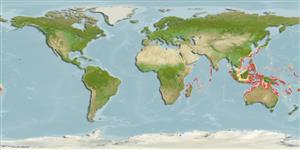Classification / Names
Common names from other countries
Main reference
Size / Weight / Age
Max length : 4.5 cm SL male/unsexed; (Ref. 48637)
Environment
Marine; reef-associated; depth range 6 - 45 m (Ref. 90102)
Climate / Range
Subtropical, preferred ?
Distribution
Indo-Pacific: in the western Pacific from the Ryukyu Islands south to the Great Barrier Reef, Lord Howe Island, and New Caledonia, east to Fiji and Samoa, and the Hawaiian Islands. Only the Chagos Archipelago in the Indian Ocean, but other localities are expected. The authors report the species for the Red Sea from a specimen from Sudan, one at Ras Bob on the southeast coast of the Sinai Peninsula, and one from the Seven Brothers Islands in the Gulf of Aden near the southern end of the Red Sea (Ref. 89154).
Known as widespread in the tropics south to Montague Island (Ref. 9002).
Countries | FAO areas | Ecosystems | Occurrences | Introductions
Short description
Dorsal
spines
(total): 6 - 7;
Dorsal
soft rays
(total): 7-9;
Anal
spines: 1;
Anal
soft rays: 7 - 9. Dorsal-fin rays VI + I,7-I,9, usually I,8; anal-fin rays I,7-I,9, usually I,8; scales usually extending forward to above pectoral-fin base, the longitudinal scale count 33–53 (mean scale count 47); body depth at origin of anal fin 10.5–17.8% SL; body progressively compressed posteriorly; head width slightly greater than head depth; snout short, the length equal to or less than orbit diameter; gill opening extending forward to posterior margin of orbit; one or two canine teeth at side of lower jaw; caudal fin truncate with rounded corners; pelvic fins short, round, and cup-like; pelvic spines short and fleshy; nape and body transparent dorsally with seven narrow red bars that broaden as they pass onto dusky golden ventral part of body (on some individuals, the red and gold tend to merge, making the bars indistinct); a white to pale yellow line visible dorsally on vertebral column. A small species, generally less than 20 mm SL (Ref. 89154).
IUCN Red List Status (Ref. 115185)
Threat to humans
Harmless
Human uses
More information
Common namesSynonymsMetabolismPredatorsEcotoxicologyReproductionMaturitySpawningFecundityEggsEgg development
ReferencesAquacultureAquaculture profileStrainsGeneticsAllele frequenciesHeritabilityDiseasesProcessingMass conversion
Tools
Special reports
Download XML
Internet sources
Estimates of some properties based on models
Phylogenetic diversity index
PD50 = 0.5000 many relatives (e.g. carps) 0.5 - 2.0 few relatives (e.g. lungfishes)
Trophic Level
3.2 ±0.3 se; Based on size and trophs of closest relatives
Resilience
High, minimum population doubling time less than 15 months (Preliminary K or Fecundity.)
Vulnerability
Low vulnerability (12 of 100)
Price category
